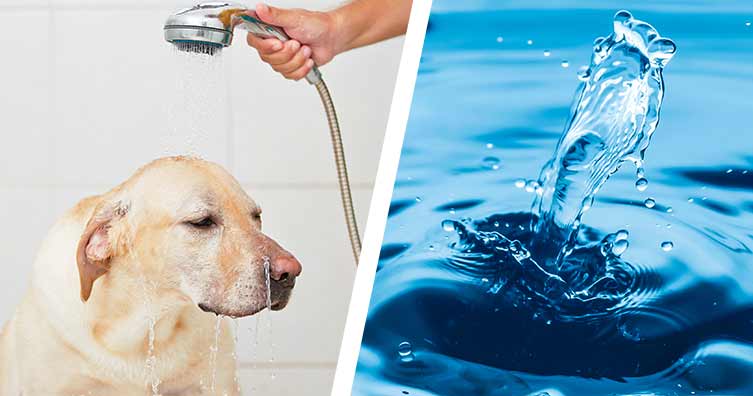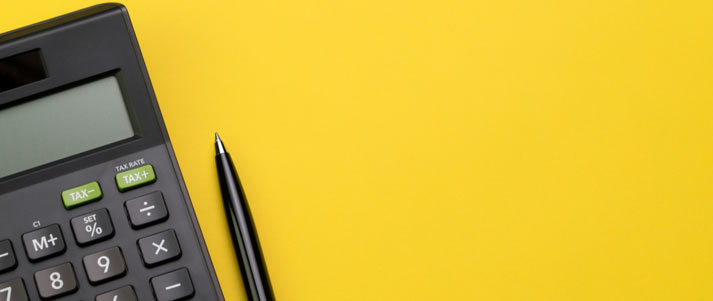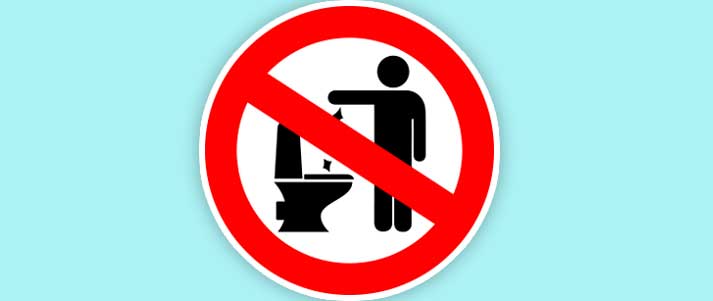13 ways to reduce your water bill
Unless you're set on becoming the world's smelliest (and thirstiest) student, you'll need water. The bad news is: it's expensive. The good news is: we're here to help!

Your student water bill is one of the easiest bills to deal with. As water is essential for good hygiene and general survival, it should be one of the first things you sort out when moving into a new house.
But naturally, you'll want to make sure you're spending as little as possible on your water bill. Similarly, you'll want to use as little water as possible to cut your living costs (and do your bit to save the planet).
We've come up with a simple guide to make sure you get everything sorted as soon as possible. And we've even included a list of money-saving tricks that could save you £100s.
What's in this guide?
How is your water bill calculated?

Credit: eamesBot – Shutterstock
One of the most important things to know about water bills is that each area of the country is covered by one supplier only (find your area's water supplier). This means that, unlike with energy bills, there's no way to switch providers and get a better deal.
That said, there are two different ways to pay for your water usage (the method you use will impact the price):
-
Water meter
If your student house has a water meter, you'll simply pay for the amount of water you use. This means that if you follow our advice below on saving water, you could save a lot of money.
Water meters look pretty similar to electricity and gas meters. You'll either find them inside the building where a water main is (e.g. under the sink) or outside the building near outdoor pipes (or where you can see water mains on the ground).
The meter will measure how much water you use. On top of that, your local supplier will likely take a reading twice a year and charge you accordingly.
Water companies are usually happy to fit a meter free of charge, so if you do think it would work for you, it might be worth having a chat with your landlord.
-
Standard tariff
If your water bills are unmetered (i.e. on a standard tariff), you'll get billed a fixed amount depending on the value of your property.
We've been told by NI Water that, in Northern Ireland, domestic customers don't currently need to pay a bill for water and sewerage services.
In England and Wales, the average annual water and sewerage bill is around £473. This works out as approximately £1.29 per day.
And if you're living in Scotland, full-time students are exempt from paying household water and wastewater charges. But this is only the case if the property is occupied by full-time students only.
For those who do pay water bills in Scotland, the costs vary, but the average bill has increased by around £35.95 per year in 2024/25.
You'll pay a standard water charge that's automatically included in your council tax bill unless you choose to have a meter fitted instead.
If you choose to have a water meter installed, you'll need to arrange this with Scottish Water directly. They'll bill you separately from your council tax.
It's worth knowing that Scottish Water does charge a service and installation fee. Unless you'll be using much less water than the standard rate, it's unlikely that this will work out much cheaper.
How to set up your water bill
Setting up your water bill is pretty straightforward. After all, there's no competition involved when it comes to prices, so you won't have to spend hours tracking down the best offers as you do with gas, electricity and broadband bills.
Here's how to set up paying your water bills in four easy steps:
- Find your supplier – Once you've figured out what kind of tariff you're on, all you have| to do is find out who your local water supplier is (using this tool) and get in touch online or over the phone. We'd recommend doing this on the first day you move in.
- If you're on a water meter, check it ASAP – For those paying by meter, make sure you take a reading as soon as you move in. You don't want to be charged for water you didn't use.
- Know your payment dates – If you're on a standard tariff, you'll likely need to pay either monthly or quarterly. For those on a meter, it'll probably be every six months. However, this can vary from supplier to supplier. You should also take a meter reading when you move out to avoid being charged for water used by the tenants after you.
- Make sure everyone's name is on the bill – One person in your household could be in charge of paying the water bills. But, having all of your housemates' names on the bill means you'll each be responsible if you fall behind on payments, rather than one person having to take responsibility. We've got more tips on how to split your household bills in our guide.
How to save money on your water bill
These are the best ways to lower your water bills:
-
Check your supplier for help with your bills
Everything seems to be getting more expensive in the cost of living crisis – including your water bill. If you're struggling to keep up with your water bill, you could be eligible for some help.
Check with your water provider to see what type of help they offer. This could be in the form of hardship schemes or fund independent charitable trusts. Each supplier has different schemes available, so make sure to reach out if you're struggling.
Note that you often have to be claiming benefits to be eligible for this help though.
-
Never boil more water than you need

Credit: vovidzha – Shutterstock
A good old brew tends to solve pretty much everything, but overfilling the kettle can cause some serious wastage.
Only fill the kettle with just enough water for what you'll actually need. Not only will this save water, but electricity and time too.
-
Only use your washing machine when it's full
It's easy to reduce your water bill by increasing your wash loads. You can do this by either waiting for your dirty laundry pile to grow or sharing a load with your housemates (if you're comfortable doing that, of course).
Even if your washing machine has a half-load button, it will still use over half the amount of water used in a full load. It's better to fill it up!
Generally, you can wash lights and darks together at 30°C as long as your detergent supports washing at this temperature. There's no excuse not to wash them all at once.
Just bear in mind that you shouldn't wash new dark clothes with lights as the dye might run on the first few washes.
And, for things like underwear, towels and bedding, it's best to wash them at higher temperatures to make sure they're sanitised. You can use our tips on how to wash your clothes to save more money on laundry.
-
Use a dishwasher instead of washing up
Lazy people, rejoice! It's thought that energy-efficient dishwashers use less water than hand-washing.
However, as with your washing machine, you should only use your dishwasher if it's full. If you run the dishwasher when it's not full, you can end up using more water and energy than if you'd washed up by hand.
Of course, not every student house is blessed with a dishwasher. If you're not one of the lucky ones, this next tip is for you...
Get a box of dishwasher tablets when you sign up for a free trial with Smol. -
Use a washing-up bowl
If you don't have a dishwasher in your student house, or the dishes have stains too tough for a machine to tackle, you'll need to wash them by hand. If so, we recommend using a washing-up bowl rather than washing straight in the basin.
Washing up bowls are smaller than the sink itself. A smaller container means less water is required to fill it up.
What's more, there should be a little gap between the edge of the bowl and the edge of the sink. This is perfect for rinsing your dishes without tampering with the warm soapy water in the bowl.
-
Store cold water in the fridge
It sometimes takes a few seconds for your tap water to turn to your preferred temperature. Over a year, you could be wasting a lot of water by waiting for the water to turn cold.
Instead, have a jug of water in the fridge at all times. This way, you'll be able to avoid wasting water each time you have a drink.
If you're not sure what to use, check out this jug. It's big enough to fill a few glasses, and should easily fit in the fridge door.
-
Have shorter showers
In theory, a shower should use up less water than a bath. But this doesn't apply if you tend to stand in the shower long enough to come out looking like a shrivelled-up prune.
A 15-minute shower will use almost the same amount of water as a bath. This almost doubles if you're using a power shower – scrub up fast!
-
Don't use the toilet as a bin

Credit: Arcady – Shutterstock
We've probably all been guilty of this at some point, but things like tissues, tampons and face wipes don't belong in the toilet.
Not only is flushing them harmful to the environment, but you'll be wasting a lot of water too. What's more, many of these things aren't flushable anyway, so they can clog up the pipes somewhere along the line.
You probably have a perfectly functioning bin anyway, so use it.
-
Replace leaky taps
If your tap is dripping, ask your landlord to fix it ASAP.
Not only will the sound of a leaky tap drive you crazy, but it'll also be wasting an astounding amount of water. This can lead to a very expensive water bill.
Check our guide to saving money on your energy bills for more tips on how to keep costs down. -
Turn off the taps when brushing your teeth
Whenever you're brushing your teeth, turn off the tap during intervals when you don't need water.
You don't need the water to be particularly cold or hot, so there's no reason to keep the tap on. Turning off the taps whenever possible is a small but effective way to reduce your water bill.
-
Bag water-saving freebies
This might not seem economical to water suppliers, but many companies offer water-saving freebies. While they'll end up making less money from you, they know that being good to the environment is more important sometimes.
Examples of these would be extensions for your tap that reduce water flow, showerheads that distribute the flow more efficiently and timers to use in the shower.
Grab your water-saving freebies.
-
Reduce your flush
Toilets without dual flush settings (which let you choose how much water to flush) use an average of up to 13 litres of water for every single flush.
You can reduce the amount of water used by putting a brick or a big plastic bottle filled with water in your toilet cistern. This will reduce the amount of water in each flush without affecting the pressure.
Otherwise, the simple solution would be to flush less.
The motto "if it's yellow, let it mellow; if it's brown, flush it down" might sound gross, but it could save you cash. Nonetheless, make sure all flatmates are in agreement before you start implementing this method.
-
Collect rainwater
If you're lucky enough to have a garden with your student house and fancy trying your hand at a spot of gardening, don't feel the need to get the garden hose out.
Most garden plants don't need water every day and a garden hose uses 1,000 litres of water an hour.
Instead, you can collect rainwater in a water butt or any kind of large vessel to use for watering the plants. It's supposed to be better for them anyway as it's softer and doesn't have the added chemicals tap water does.
Our guide to student bills includes more advice on how to get the best deals, set up each account, and split the payments.








